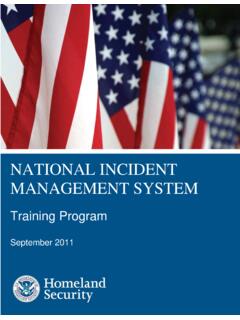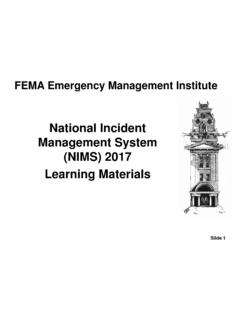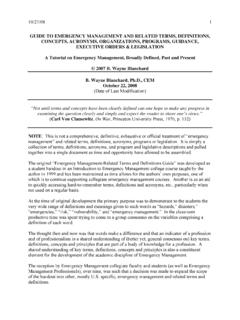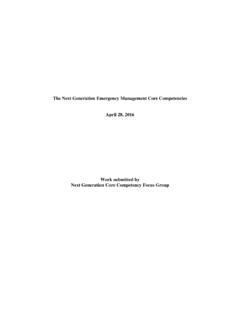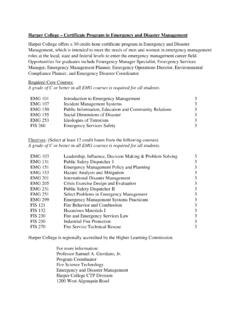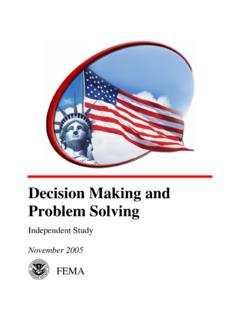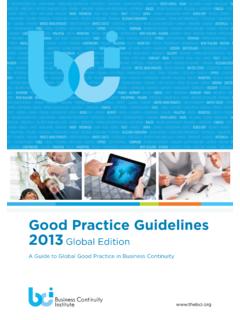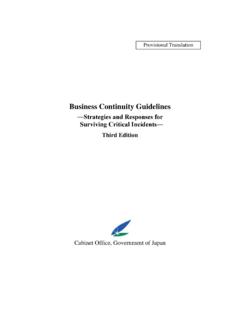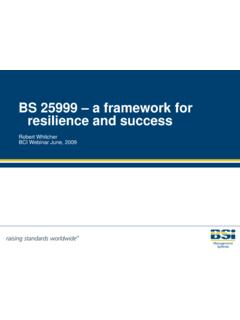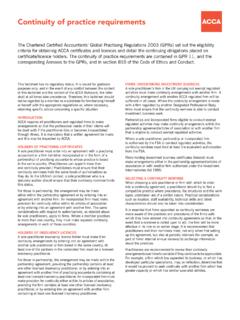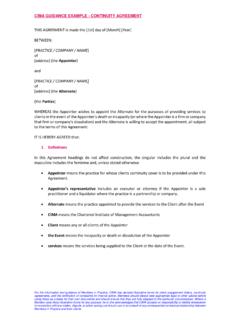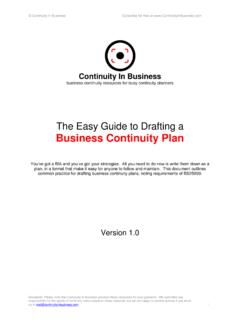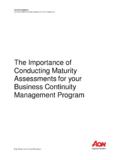Transcription of Continuity Guidance Circular 1 (CGC 1)
1 (States, Territories, Tribal, and Local Government Jurisdictions and Private Sector Organizations) January 21, 2009 FEMA Continuity Guidance Circular 1 (CGC 1) Continuity Guidance for Non-Federal Entities This page is intentionally left blank. CGC 1 ii The President issued the National Security Presidential Directive-51/Homeland Security Presidential Directive-20 (NSPD-51/HSPD-20) National Continuity Policy in May 2007 to establish and maintain a comprehensive and effective national Continuity capability in order to ensure the preservation of our form of Government under the Constitution and the continuing performance of National Essential Functions under all conditions.
2 In August 2007, the President approved the National Continuity Policy Implementation Plan to build upon the Policy and provide Guidance to executive departments and agencies on appropriately identifying and carrying out their Primary Mission Essential Functions that support the eight National Essential Functions the most essential functions necessary to lead and sustain the Nation during a catastrophic emergency. To provide the operational Guidance to implement this policy, the Department of Homeland Security, Federal Emergency Management Agency, in coordination with our non-federal partners, has developed Continuity Guidance Circular 1 (CGC 1), Continuity Guidance for Non-Federal Entities. The purpose of this Guidance document is to provide direction for the development of Continuity plans and programs for non-federal entities.
3 Effective Continuity planning and programs facilitate the performance of essential functions during all-hazards emergencies or other situations that may disrupt normal operations. The primary goal of Continuity is the continuation of essential functions. In this Guidance document, the elements of a viable Continuity capability are identified and discussed. These elements are critical to establishing and maintaining a comprehensive and effective Continuity capability. Continuity programs and operations are good business practices that ensure critical services will be available to the Nation s citizens under all conditions. The provisions of this Guidance document are applicable for State, local, territorial and tribal governments and the private sector.
4 R. David Paulison Administrator Federal Emergency Management Agency CGC 1 iii This page is intentionally left blank. CGC 1 iv TABLE OF CONTENTS 1. PURPOSE ..1 2. APPLICABILITY AND SCOPE ..1 3. SUPERSESSION ..1 4. 5. REFERENCES ..1 6. 7. 8. PROGRAM MANAGEMENT ..3 9. ELEMENTS OF A VIABLE Continuity CAPABILITY FOR NON-FEDERAL ..7 10. COORDINATION WITH NON-FEDERAL ENTITIES AND FEDERAL DEPARTMENTS AND AGENCIES ..11 11. Continuity PLAN OPERATIONAL PHASES AND 12.
5 ROLES AND 13. POINT OF CONTACT ..14 14. DISTRIBUTION ..14 ANNEX A. PROGRAM PLANS AND PROCEDURES .. A-1 ANNEX B. RISK ANNEX C. BUDGETING AND ACQUISITION OF ANNEX D. ESSENTIAL D-1 ANNEX E. ORDERS OF SUCCESSION ..E-1 ANNEX F. DELEGATIONS OF AUTHORITY .. F-1 ANNEX G. Continuity G-1 ANNEX H. Continuity H-1 ANNEX I. VITAL RECORDS MANAGEMENT .. I-1 ANNEX J. HUMAN ANNEX K. TEST, TRAINING, AND EXERCISE (TT&E) PROGRAM .. K-1 ANNEX L. DEVOLUTION OF CONTROL AND DIRECTION ..L-1 ANNEX M. RECONSTITUTION OPERATIONS ..M-1 ANNEX N. Continuity PLAN OPERATIONAL PHASES AND N-1 ANNEX O. ACRONYMS .. O-1 ANNEX P. GLOSSARY .. P-1 ANNEX Q.
6 AUTHORITIES AND REFERENCES .. Q-1 CGC 1 v This page is intentionally left blank. CGC 1 1 Continuity Guidance Circular 1 (CGC 1) Number Date Office CGC 1 January 21, 2009 FEMA National Continuity Programs TO: HEADS OF NON-FEDERAL ENTITIES SUBJECT: Continuity Guidance FOR NON-FEDERAL ENTITIES PURPOSE: This Guidance document provides direction to non-federal entities for developing Continuity plans and programs. Continuity planning facilitates the performance of essential functions during all-hazards emergencies or other situations that may disrupt normal operations. By continuing the performance of essential functions through a catastrophic emergency, the State, local, territorial, and tribal governments (non-Federal Governments entities or NFGs) support the ability of the Federal Government to perform National Essential Functions (NEFs), continue Enduring Constitutional Government, and ensure that essential services are provided to the Nation s citizens.
7 A comprehensive and integrated Continuity capability will enhance the credibility of our national security posture and enable a more rapid and effective response to, and recovery from, a national emergency. 1. APPLICABILITY AND SCOPE: The provisions of this Guidance document are applicable to all non-federal entities. The State, local, territorial and tribal governments, and the private sector are hereinafter referred to as non-federal entities or organizations. 2. SUPERSESSION: The provisions of CGC 1 supersede: Interim Guidance on Continuity of Operations Planning for State and Local Governments, dated May 2004. 3. AUTHORITIES: See Annex Q Authorities and References. 4. REFERENCES: See Annex Q Authorities and References. 5.
8 POLICY: It is the policy of the United States to maintain a comprehensive and effective Continuity capability composed of Continuity of Operations (COOP) and Continuity of Government (COG) programs to ensure the preservation of our form of Government under the Constitution and the continuing performance of NEFs under all conditions (National Security Presidential Directive (NSPD)-51/Homeland Security Presidential Directive (HSPD)-20, National Continuity Policy). Continuity requirements must be incorporated into the daily operations of all agencies to ensure seamless and immediate continuation of Mission Essential Function (MEF)/Primary Mission Essential Function (PMEF) capabilities so that critical government functions and services remain available to the Nation s citizens.
9 CGC 1 2 Continuity planning is the good business practice of ensuring the execution of essential functions under all circumstances. Continuity includes all activities conducted by jurisdictions to ensure that their essential functions can be performed. This includes plans and procedures that delineate essential functions, specify succession to office and emergency delegation of authority, provide for the safekeeping of vital records and databases, identify alternate operating strategies, provide for Continuity communications, and validate these capabilities through test, training, and exercise (TT&E) programs. Today s changing threat environment and the potential for no-notice emergencies, including localized acts of nature, accidents, technological system failures, and military or terrorist attack-related incidents, have increased the need for Continuity capabilities and planning across all levels of government and the private sector.
10 6. BACKGROUND: Continuity planning is a fundamental responsibility of public institutions and private entities to our nation s citizens. Continuity planning facilitates the performance of essential functions during an emergency situation that disrupts normal operations and/or the timely resumption of normal operations once the emergency has ended. A strong Continuity plan provides the organization with the means to address the numerous issues involved in performing essential functions and services during an emergency. Without detailed and coordinated Continuity plans, and effective Continuity programs to implement these plans, jurisdictions risk leaving our nation s citizens without vital services in what could be their time of greatest need.

